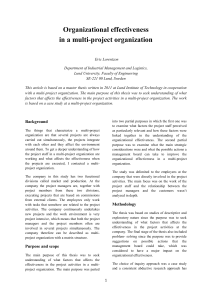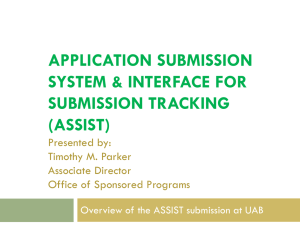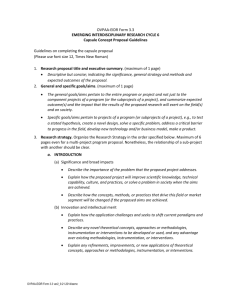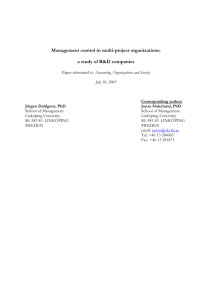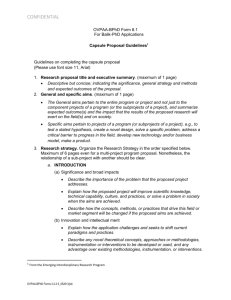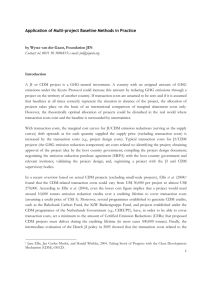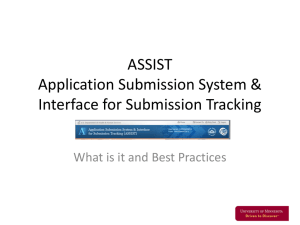Management of Multi-projects In a Process Oriented Organization
advertisement
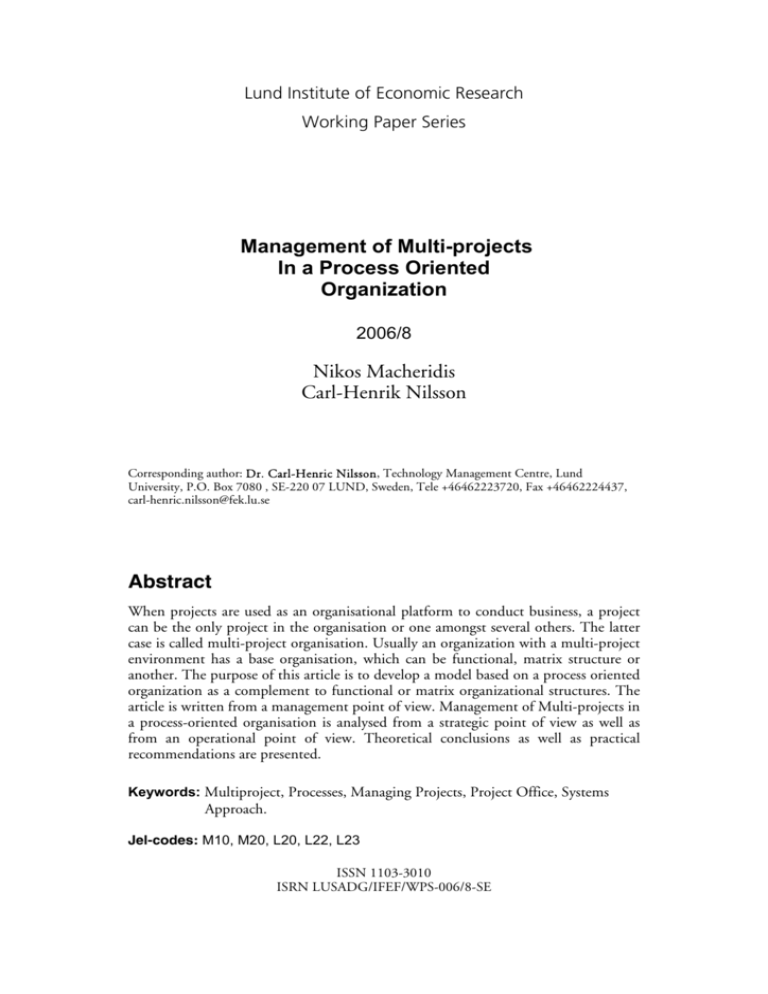
Lund Institute of Economic Research Working Paper Series Management of Multi-projects In a Process Oriented Organization 2006/8 Nikos Macheridis Carl-Henrik Nilsson Corresponding author: Dr. Carl-Henric Nilsson, Technology Management Centre, Lund University, P.O. Box 7080 , SE-220 07 LUND, Sweden, Tele +46462223720, Fax +46462224437, carl-henric.nilsson@fek.lu.se Abstract When projects are used as an organisational platform to conduct business, a project can be the only project in the organisation or one amongst several others. The latter case is called multi-project organisation. Usually an organization with a multi-project environment has a base organisation, which can be functional, matrix structure or another. The purpose of this article is to develop a model based on a process oriented organization as a complement to functional or matrix organizational structures. The article is written from a management point of view. Management of Multi-projects in a process-oriented organisation is analysed from a strategic point of view as well as from an operational point of view. Theoretical conclusions as well as practical recommendations are presented. Keywords: Multiproject, Processes, Managing Projects, Project Office, Systems Approach. Jel-codes: M10, M20, L20, L22, L23 ISSN 1103-3010 ISRN LUSADG/IFEF/WPS-006/8-SE 1. Introduction In a multi-project environment several projects can be performed at the same time (Van Der Merwe, 1997; Fricke & Shenbar, 2000; Engwall, 2001:6; Nilsson, 2004; etc). Multi-project organizations share some common characteristics (Eskerod, 1996; Lee & Miller, 2004; etc). Projects are often not the primary organisational structure but formed across a base organisation. In a multi-project environment the projects share resources, such as personnel, facilities, infrastructure and top management, with the base organisation and use the same administrative systems, communication systems and control systems. Project documentation and the generic project process are sometimes standardised. The conditions descript above raises the question how projects in a multi-project environment can be managed and organized firstly in relation to each other and secondly in relation to the overall business of the organization. Usually there is a base organisation, which can be functional, matrix structure or otherwise (Engwall 2001:8; Gray & Larson, 2003; Söderlund & Bredin, 2005; etc). Nobeoka & Cusumano (1995), Van Der Merwe (1997), Engwall (2001) and other researchers suggests that the fit between organizational structures in multi-project environment, and the base organisation has potential for improvements. In this article the preconditions of a process oriented base organisation as a vehicle for running a multi-project organisation is analysed (Abdomerovic & Blakemore, 2002; Anavi-Isakow & Golany, 2003; etc). The process oriented organization is viewed as a complement to functional or matrix organizational structures rather than as a full substitute. Process oriented organization focus on processes serving the customer, rather than functions connected to management in an internal hierarchy (Ljungberg & Larsson, 2001). A crucial task of a process-oriented organization is to continuously improve the processes that, by definition, are repetitive. Processes and projects are thus fundamentally different from each other in the respect that processes are running continuous without end while the definition of a project rests on the fact that it has a defined end. However, with this in mind, the similarities are substantial; • A clear goal orientation – main processes are aimed at satisfying the customer as is the project (although in projects the customer is often internal). • Time focus - in processes the flow of resources through activities is paced as the process is carried out while in the project the project lifecycle is central. Resource orientation - Process oriented organisations evaluate the flow while in project management the performance of the project itself is evaluated. • The similarities between process and project lead us to the purpose of this paper: to develop a model for multi-project management in a process oriented organization. We apply a managerial perspective and highlight the process-oriented organization both from a strategic and operational point of view. 1 2. Multi-project environment Project management has been studied during the last decades and an increased interest has been redirected toward multi-project management. According to Van Der Merwe (1997) the area of multi-project is a largely un-researched area. A few years later (2000) Fricke & Shenbar note that “the current literature is still focused on the study of a single project in isolation, assuming limited interactions among projects”. Anavi-Isakow & Golany (2003) considers that most of the literature on project management has been dedicated single projects. In recent years there is a growing interest in questions related to management of multi-project environment (Meredith & Mantel, 1995; Shtub, Bard & Globerson, 1994; Van Der Merwe, 1997; Levy & Globerson, 1997; Fricke & Shenbar, 2000; Engwall, 2001:6, 2001:8; Chan & Chung, 2002; Anavi-Isakow & Golany, 2003; Gray & Larson, 2003; Nilsson, 2004). Over time we can see an increasing interest in the area of multiproject management. The need for more research in the area of multi-project arises from the fact that projects are usually running in parallel in organisations. Payne (1995) suggests that up to 90% of all projects occur in a multi-project context. Fricke & Shenbar (2000) support this when they write “few, if, any, actual projects are carried out in complete isolation”. The same is also expressed by Engwall (2001:6). According Engwall (2001:8) the multi-project environment is an important research field based on two basic arguments. One is that the analysis of single projects requires that the organizational context must be included. The other is that multi-project environment is a significant aspect of modern organizations. Hendricks, Voeten & Kroep (1999) contributes with two “practical” reasons to study multi-project environment: ultra short time-to-market and cost reductions. Fricke & Shenbar (2000) define multiple projects as a setting in which more than one project is carried out at the same time. Many researchers (Shtub, Bard & Globerson, 1994; Van Der Merwe, 1997; Hendriks, Voeten & Kroep, 1999; Engwall, 2001:6; Nilsson, 2004) define multi-project in a similar way, multi-project is used to define organizational environments in which many different projects are performed at the same time. The terms “multi-project” and “multi-project organization” are used synonymous with ”multi-project environment”. A multi-project environment can include different types of projects, e.g. product development projects, organizational development projects and marketing projects. The projects can have different characteristics and can be in various stages of a project life cycle. Payne (1995) differentiates between projects in terms of size, required skills, and urgency. • Size refers to number of actors involved in a project, the volume of required resources etc. A situation that brings differences of size to the fore is when a project, which is not large enough to stand alone, must share common resources. • Variety of required skills refers to differences between the skills used in projects. Differences on skills depends on project output, project size etc. Different degrees of urgency lead to increased project complexity. • 2 From a management point of view it is important to take into consideration the characteristics of multi-project environment and how those characteristics impact the design of an organizational structure aimed at managing multi-projects. Characteristics of multi-project environment pointed out by Eskerod (1996) and Lee & Miller (2004) are; that tasks are carried out in projects, interdependencies between projects, the projects share a common resource pool, the employees can be assigned to several projects or other tasks at the same time, trade-offs between the utilization of resources and the on-time completion of individual projects. Engwall (2001) consider multi-project rather as an organization and management form than as a way to perform tasks. According Engwall the multi-project comprises the perspectives of the hierarchical levels above the project manager but also the perspective of multitasking, individual team members, who are engaged in several projects at the same time. Fricke & Shenbar (2000) discuss four ideas for management consideration in a multi-project environment. 1. Project selection. 2. Project classification, priorities, and policies. Anavi-Isakow & Golany (2003) point out problems related to control mechanisms for multi-project environments. The need of priorities depends on the fact that many projects require the same resources at the same time. 3. Resource allocation, which has also been studied by Lova, Maroto & Tornos, 2000 and Fatemi Ghomi & Ashjari, 2002. Allocation of human resources has been studied by Hendriks, Voeten & Kroep, 1999. 4. Management skills. Develop management skills is related to knowledge transfer between projects. A crucial problem relating to management skills, discussed by Engwall (2001:8), is how knowledge and experiences transfers between projects. In a multi-project environment it is important to have a balance between long-term knowledge development of the base organization and knowledge development at project level. 3. Organizational structures to manage multi-project environment Engwall (2001:8) propose two principle ways to organize multi-project environments; functional structure and matrix structure. A functional structure is common in civil engineering, movie making, theatres and software consulting. According Gray & Larson (2003) the project is split up into different parts that are delegated to the respective functional units and each unit is responsible for completing its part of the project. When a functional area with dominant interest in the success of the project, is given the responsibility of coordinating the project. This can however, according to Gray & Larson, lead to drawbacks such as; poor integration across functional units, it generally takes longer to complete projects though this functional arrangement and the motivation of people assigned to the project can be weak. 3 The other way to organize multi-project environment is in a matrix structure. According Gray & Larson (2003) matrix arrangements can be designed in a variety of ways and Söderlund & Bredin (2005) relate that to the classical dilemma concerning double management and double loyalties. The aim of matrix structure is to balance the requirements from various functional areas and at the same time give project managers responsibly to coordinating the project thru organizational boundaries. According Ljungberg and Larsson (2001) the draw-back of a project matrix is that power and control of resources often remain in the base organization because this is permanent, transformation of knowledge and experiences between projects can cause problems. Managers are often focusing on the differences between projects rather than the similarities, and there is a risk that the motivation to continuously work with improvements is not always on top since projects are temporary. A third alternative to organize multi-project business, discussed by Söderlund & Bredin (2005), is project oriented organizational structure. In this structure the individual is primarily member of the project. Unlike the matrix structure the individual doesn’t belongs to a base organization but often he or she moves from one project to another. Project managers have the overall responsibility for the project and control of allocated resources to the project and are also responsible for the performances. Project work is performed in different specialized functional areas. Project teams have the right to develop own rules and procedures. As early as 1996 Eskerod (1996) pointed out that many companies used a project oriented organizational structure. Levy & Globerson point out that most multi-project hightech companies are organized in a matrix structure. Other organizations that use matrix structure to manage multi-project environment are according Hendriks, Voeten & Kroep (1999) R&D organizations. In those organizations a common and important problem is to allocate people to different projects. We have above given a short recap of common organizational structures to manage multi-project environments and discussed advantages and limits of each organizational structure. We agree with Payne (1995) when he concludes that the potential for improvement in management of simultaneous multiple projects are significant. The organizational design of the base organization is critical in this aim, which is also observed by others. Nobeoka & Cusumano (1995) support that in order to achieve coordination both cross functionally and intra-functionally simultaneously requires a multi-project perspective. Van Der Merwe (1997) points out three critical areas in multi-project management where solutions need to be found - organizational structure, control and prioritization of projects. Fricke & Shenbar (2000) suggests that future studies in multi-project should focus on organizational functions. Engwall (2001) attract attention to organizational structure as a significant issue for future research. 4. Multi project management in process oriented organizations In process oriented organizations multi-project environment can be organized firstly as a whole which means that projects are organized in relation to other projects and in relation to the base organization and secondly at the operational level where the projects are planned, organized and carried out. Advantages of process oriented organizations are the possibilities for management to consider problems concerning 4 capacity, conflicts, commitment, content and complexity related to characteristics of multi-project environment and at the same time take into account management considerations concerning project selection, project classification, priorities and policies, allocating resources and managing the mixture of projects, and the development of management skills. This paper is focused on management considerations. Design of process oriented organization to manage multiproject environment Process orientation has attracted a steady growth of interest during the 1990-s with BPR (Business Process Reengineering) as a leading idea. Later studies and practical implementations have slowly abandoned the strictest reengineering interpretations in favour of focusing on current processes. (Hammer, 2001) Characteristics of process orientation that are advantageous in a multi-project environment are flow orientation, focus on customer, and a comprehensive view on quality and value added. Another advantage of process orientation is the possibility for the base organization to delivery results and react faster to novel circumstances. A further advantage is that process orientation can lead to a reduction of the number of organizational levels, which will make the management of multi-project environment easier. Another advantage is that process orientation can facilitate to relate projects to base organization without loosing focus on the project processes. Project management processes are usually categorised into core processes, support processes and management processes (Ljungberg & Larsson, 2001). The base for classification is customer value. Core processes provide a direct value to the customer. Examples are; to develop a product, sell, distribute, and produce. Theses processes are often cross-functional. They are necessary to carry out the project and delivery project results. Support processes support core processes so that they will be performing efficiently. Support processes can be found both in projects, i.e. project documentation, and in a base organization, i.e. administrative processes. The most efficient set-up in a multi-project environment is that base organization develops support processes that serve many projects. Management processes can exist for the whole organization as well as at the project level. Management processes for whole organization are processes in order to manage the organization through objectives, strategies, plans and policies. At the project level, management processes has the function to manage the project life cycle and the development of the project output. Management processes also has the function to coordinate core processes and support processes. Mattsson (1999) distinguish between main processes and sub processes. This classification is depending on the level of detail. Sub processes are parts of the main processes. Another classification named by Mattsson is after organizational scope. Functional processes are processes that run inside one function. Inner-organizational processes are processes that run through many organizational parts or functions in the same organization. Intra-organizational processes run across many organizations. In order to control projects two roles can be defined; he project owner or sponsor, who is financing the project and the project manager responsible for executing the 5 project. The primary duty of the project owner is to bring visibility to a project and to maintain a link between the project and the organization as a whole. The project manager brings project management procedural expertise to the project team. The project manager guides the project team through the different stages of the project life cycle by fulfilling the roles of decision maker, facilitator, educator and consultant. It is the project manager’s responsibility to manage the project across departmental boundaries. The primary duty of project manager is to carry out the project and delivery project result according to budget, time and scope. Strategic management of multi-projects in a process oriented organization Dietrich & Lehtonen (2005) discuss how to implement strategies successfully through projects in order to maintain a competitive edge. Artto & Wikström (2005) highlighting the strategic importance of projects to the overall business of an organization bringing the concepts of “business” and “project” together. They suggest that “projects are part of overall business and a central part of the development, strategic sight and maintaining of the firm’s competitiveness” (p 349). One strategic issue in multi-project environment is integration between projects. Boznak (1988) suggest that multi-project integration can become the key to a company's productivity. Payne (1995) maintains that integration between projects has to do both internal interfaces in a multi-project and with interfaces with other projects. Interfaces are not always directly and immediate but also indirect, for instance via intermediaries such as common-resources providers. In a multi-project environment it is important to integrate between projects in order to harvest synergies, to use common resources etc. Interaction of interfaces between the projects in the multi-project environment can lead to technical and to economical compromises, which may satisfy the single project’s requirement but sub-optimise from a multi-project point of view. Gray & Larson (2003) discuss integrated management of projects with the overall strategy and within actual project management. In the first area the focus is on selection of projects that must support the overall strategy of the organizations. In the second area the focus is on the project management process that defines how project will be implemented and delivered. Fricke & Shenbar (2000) notice differences between success factors in multi-project environment and success factors in traditional single-project management. Differences have to do with resource allocation and flexibility. Fricke & Shenbar point out that factors such as; clear goals, top management support, ownership, experienced staff, and communication which are important in the management of a single project also are significant in the management of multi-projects. They find that factors such as ownership, staff experience and communication, division and assignment of resources, prioritization and customized management style, take on additional dimensions in multi-project environment as compared to single project management. Factors such as client acceptance and troubleshooting, technical issues that are affecting either the success or failure of a project are not affecting the success or failure of multi-projects. 6 Multi-project environment Management considerations Strategic Issues Project selection Project visibility Project portfolio Fit between projects Success factors Project classification, priorities and policies Project integration Project visibility Success factors Allocating resources and managing the project mix Project integration Project portfolio Developing organizational skills Develop competencies to manage interactions between projects Develop competencies to manage project portfolios in multi-project environment Develop competencies to manage project visibility in multi-project environment Develop competencies to manage success factors to carry out projects in multiproject environment Figure 1. Strategic issues in multi-project environments. Figure 1 summarizes a statement of process-oriented organization to manage multiproject environment from a strategic point of view. The figure relates strategic issues to management considerations in a multi-project environment. Analysis of strategic issues concerning integration between projects, such as; project portfolio, project visibility and success factors, involves capturing the process dynamics of a multiproject environment. The analysis also requires understanding of the complexity of a multi-project environment both from the functional department perspective and from single project perspective. The combination of the responsibilities of the project owner and the project manager provides a platform for a delicate balancing act. Firstly balancing functional authority and project authority and secondly balancing the long-terms objectives of the base organization’s functional departments with the more short-terms objectives of the projects. Operational management of multi-projects in a Process oriented organization A process oriented organization focuses, from an operational point of view, on management and control of a multi-project environment. Management and control are more related to operational issues rather than strategic. The first advantage of a process-oriented organization is that a multi-project environment is dynamic instead of stable and predictable. The other advantage is that it encourages engagement and commitment in project teams and action by project management instead of topdown decision-making. Fundamental in process orientation is performance measurement. Bryde (2005) suggest that in order to manage a multidimensional framework of performance measurement systems and key performance indicators it is necessary to consider and balance various stakeholders’ perspectives. Bryde notice also that a framework of 7 performance measurement systems and key performance indicators must consider the difference between project management success and project success. Ljungberg & Larsson (2001) suggest that objectives of every activity must be decided and how to measure the fulfilment of the objectives must be specified. Measures can be financial, such as; cost and return on investment, as well as non-financial, such as; quality, competence and innovation. The selection of specific measures must take into consideration the type of process, project classification, project visibility, organizational responsibilities and the circumstances of multi-project environment. Nilsson & Ford (2004) develops the comprehensive Intellectual Potential framework for process based project measurements based on Kaplan & Norton’s (1996) Balanced Scorecard, Edvinsson and Malone’s (1997) Intellectual Capital and Barney’s (1994) Resource Based View. Figure 2 summarize management of multi-project in a process-oriented organization from an operational point of view. The focus on operational level results in management considerations concerning project classification, priorities, policies and considerations concerning resource allocation and managing the project mix. Multi-project environment Management considerations Operational Issues Project selection Performance measurement Project classification, priorities and policies Managing and control links to organizational structure (project owner and project managers) Performance measurement Allocating resources and managing the project mix Performance measurement Rationalization Dependencies analysis Control and following up Multi-project tools Developing organizational skills Rationalization Develop competencies and skills to manage and control the operational businesses in multi-project environment Figure 2. Operational issues in multi-project environments. 5. Conclusions and further research The first fundamental ground for this paper is that the characteristics of a multiproject environment lead to issues concerning capacity, conflicts, commitment, context and complexity. The second fundamental ground is that in a multi-project environment management has to take into consideration; project selection, project classification, priorities and policies, allocating resources, managing the project mix and develop management skills. We take the organizational structure of a multiproject environment as the analytical starting point to propose and discuss process oriented organization as an effective way to manage a multi-project environment. 8 Process oriented organizations provide possibilities to organize and manage project processes both at single project level and multi-projects. Crucial in this work is to classify project processes. Organizational roles such as; project owner and project manager are important to organize the interdependencies between projects and between projects and the base organization. Strategic considerations as well as operational considerations must be taken into account. Based on the discussion in this article same practical recommendations can be made. A practical recommendation is to identify and visualize processes and the interaction between them. This is the starting point to classify, organize and improve project processes in order to shape the management of multi-project environment in an effective way. Another recommendation is that organizational roles such as; project owner and project manager allow the organization to integrate projects with each other and align with the overall objectives and strategy of the organization. The third recommendation is that successful organization of multi-project environment assumes; integration between projects, development and management of project portfolios, making each project visible and identification and communication of success factors to carry out projects in a multi-project environment. The data of this study is not enough to extensive conclusions (other than the practical recommendations above). More research in this area is needed. A limiting factor is the lack of empirical material concerning how process oriented organization match different kind of projects and different multi-project environment should thus be further penetrated. More empirical research is need on how process orientation is related to organizational structures such as matrix structures. Future research can focus the following topics: Organizations have different ways to organize and manage multi-project environment. Benchmark oriented studies can shed some light on which organizational structures are used by different organizations to manage multi-project environment. Several focus points are possible; one study could focus on project visibility in a multi-project environment while another study could focus on how questions related to project portfolio can be managed in process oriented organization. Another research area is to study multi-project management process in order to analyze the type and amount of project related activities for which the project management process is suitable and workable. A study could focus on analysing the relationship between multi-project environment and management processes suitable for project portfolios in multi-project environment in comparison with single projects in the same business area such as for instance telecommunication or the pharmaceutical industry. 9 References Abdomerovic M. and Blakemore G. Project process interactions. International Journal of Project Management, 2002, Vol. 20, No. 4, pp. 315-323. Anavi-Isakow S., and Golany, B. Managing multi-project environment through constant work-in-process. International Journal of Project Management, 2003, Vol. 21, No. 1, pp. 9-18. Artto K. A. and Wikström K.: What is project business? International Journal of Project Management, 2005, Vol. 23, No. 5, pp. 343-353. Barney, J. B., Bringing managers back in: a resource-based analysis of the role of managers in creating and sustaining competitive advantage. In J.B. Barney, J.C. Spender & T. Reve (Eds.), Does management matter? On competencies and competitive advantage. (pp. 1-36). Lund, Sweden: Institute of Economic Research, 1994. Boznak R. G.: Project management-today’s solution for complex project engineering. Engineering Management conference, 1988. Engineering Leadership in the 90`s, 1988, pp. 19-26. Bryde D. J.: Methods for Managing Different Perspectives of Project Success. British Journal of Management, 2005, Vol. 16, No. 2, pp. 119-131. Bryde D. J.: Establishing a project organization and a project-management process for telecommunications project management. International Journal of Project Management, 1995, Vol. 13, No. 1, pp. 25-31. Chan K. C. C., Chung L. M. L.: Integrating Process and Project Management for Multi-Site Software Development. Annals of Software Engineering, 2002, Vol. 14, No. 1-4, pp. 115-143. Dietrich P. and Lehtonen P.: Successful management of strategic intentions through multiple projects – Reflections from empirical study. International Journal of Project Management, 2005, Vol. 23, No. 5, pp. 386-391. Dooley L., Lupton G. and O'Sullivan D.: Multiple project management: a modern competitive necessity. Journal of Manufacturing Technology Management, 2005, Vol. 16, No. 5, pp. 466-482. Edvinsson, L. & Malone, M. S., Intellectual Capital – The Proven way to Establish your Company’s Real Value By Measuring its Hidden Brainpower. New York: HarperBusiness, 1997. Eskerod P.: Meaning and action in a multi-project environment. Understanding a multiproject environment by means of metaphors and basic assumptions. International Journal of Project Management, 1996, Vol. 14, No. 2, pp. 61-65. Engwall M.: Multi-project Management: Effects, Issues and Propositions for future Research. Fenix Working Paper Series WP 2001:6, Stockholm School of Economics, Stockholm. Engwall M.: Moving Out of Plato’s Cave: Toward a Multi-Project Perspective on Project Organizing. Fenix Working Paper Series WP 2001:8, Stockholm School of Economics, Stockholm. Fatemi Ghomi S. M. T. and Ashjari B.: A simulation model for multi-project resource allocation. International Journal of Project Management, 2002, Vol. 20, No. 2, pp. 127-130. 10 Fricke S. E. and Shenbar A. J.: Managing multiple engineering projects in a manufacturing support environment. Engineering Management, 2000, Vol. 47, No. 2, pp. 258268. Gray C. F. and Larson Erik W: Project Management: The managerial process. Mc GrawHill/Irwin, 2003 Hammer, M., The Agenda. London: Business Books, 2001. Hendriks M., Voeten B., and Kroep L.: Human resource allocation in a multi-project environment – Resource capacity allocation and project portfolio planning in practice. International Journal of Project Management, 1999, Vol. 17, No. 3, pp. 181-188. Kaplan, R. S., & Norton, D. P., Using the Balanced Scorecard as a Strategic Management System, Harvard Business Review, 1996, Vol. 74, No. 1, Jan-Feb., pp. 75-85. Lee B. and Miller J.: Multi-project software Engineering Analysis Using System Thinking. Software Process Improvement and Practice 2004:9, p 173-214. Levy N. and Globerson S.: Improving multi-project management by using a queuing theory approach. Industrial Project Management, 1997, Vol. 28, No. 4, pp. 40-47. Ljungberg A. and Larsson E.: Processbaserad verksamhetsutveckling. Lund, Studentlitteratur 2001. Lova A., Maroto C. and Tornos: A multicriteria heuristic method to improve resource allocation in multi-project scheduling. European Journal of Operational Research, 2000, Vol. 127, No. 2, pp. 408-424. Mattsson S-A.: Effektivisering av materialflöden i supply chains. Institutet för Transportekonomi och logistik, Växjö 1999. Meredith J. R., Mantel S. J. JR.: Project Management A managerial Approach. John Wiley & Sons, Inc., 1995. Nilsson A.: Projektledning i korta projekt Observationer av projektledares arbete i multiprojektmiljö. Handelshögskolan vid Umeå universitet, Institutionen för företagsekonomi, FE-publikationer 2004:174. Nilsson, C-H. & Ford, D., Introducing Intellectual Potential – the Case of Alfa Laval, Journal of Intellectual Capital, 2004, Vol. 5, No. 3, pp. 414-425. Nobeoka K. and Cusumano M. A.: Multi-projects strategy, design transfer, and projects performance: a survey of automobile development projects in the US and Japan. Engineering Management, 1995, Vol. 43, No. 4, pp. 397-409 Payne J. H.: Management of multiple simultaneous projects: a state-of-the-art review. International Journal of Project Management, 1995, Vol. 13, No. 3, pp. 163-168. Rautiainen K., Nissinen M., and Lassenius C.: Improving Multi-Project Management in rd Two Product Development Organizations. Proceedings of the 33 Hawaii International Conference on System Science -2000. Shenbar A. J.: A two dimensional construct model for the classification of technical projects. Engineering Management Conference, 1992. Managing a Global Environment, 1992 IEEE International, pp. 184-189 Shtub A., Bard J. F., Globerson Shlomo: Project Management Engineering, technology and implementation. Prentice Hall International Editions 1995. Söderlund J.: Projektledning & projektkompetens - Perspektiv på konkurrenskraft. Malmö, Liber 2005. 11 Söderlund J. and Bredin K.: Perspektiv på HRM - nya organisationsformer, nya utmaningar. Malmö, Liber 2005. Van Der Merwe A. P.: Multi-project management-organizational structure and control. International Journal of Project Management, 1997, Vol. 15, No. 4, pp. 223-233. Willoughby K. A.: Process improvement in project expediting: there must be a better way. International Journal of Project Management, 2005, Vol. 23, No. 3, pp. 231-236. 12 School of Economics and Management Lund University Working Paper Series Editors: Hans Landström & Ulf Elg Year No Author Title 2006 10 Johan Anselmsson Ulf Johansson 2006 9 Anna Jonsson Thomas Kalling Innovation in the competition between retailer and manufacturer brands – An examination of new-product releases in the Swedish grocery sector Challenges to knowledge sharing across national and intraorganizational boundaries: A comparison of IKEA and SCA Packaging 2006 8 Nikos Macheridis Carl-Henric Nilsson Management of Multi-projects In a Process Oriented Organization 2006 2006 7 6 Project selection from an ethical point of view Unpacking the Client(s): Constructions, Positions and ClientConsultant Dynamics 2006 5 2006 4 2006 3 2006 2 2006 1 Nichos Macheridis Mats Alvesson Dan Kärreman Andres Sturdy Karen Handley Diamanto Politis Jonas Gabrielsson Johan Anselmsson Ulf Johansson Niklas Persson Mats Alvesson Laura Empson Martin Fougère Agneta Moulettes Johan Anselmsson 2005 9 2005 8 2005 7 2005 6 El-Ansary, Adel Cerne, Annette Elg, Ulf 2005 5 Svensson, Peter Sveningsson, Stefan Larsson, Magnus Norén, Catharina Entrepreneurial Decision Making: Examining Preferences for Causal and Effectual Reasoning in the New Creation Process. A conceptual framework for understanding Customer-based brand equity and price premium in grocery categories The Construction of Organizational Identity: Comparative Case Studies of Consulting Firms Development and Modernity in Hofstede´s Culture´s Consequences: A Postcolonial Reading Customer perceived service quality in the supermarket and the discount store – Examination of a service quality measurement scale in a Swedish context Fantasies of leadership - identity work The Social Construction of Successful Practical Selling - A study of how sales persons at CR Ltd construct selling as successful An Integrative Framework for Evolving A Socially Responsible Marketing Strategy A study of inter-firm market orientation dimensions in Swedish, British and Italian supplier-retailer relationships The Survival of the Unfittest: Delinquent corporations and the production of organisational legitimacy through symbolicdiscursive fit. 2005 4 2005 3 2005 2 2005 1 2004 10 2004 9 2004 8 2004 7 2004 6 2004 5 2004 4 2004 3 2004 2 2004 1 2003 2003 10 9 2003 8 2003 7 2003 6 2003 5 2003 4 2003 3 Erlingsdottír, Gudbjörg Lindberg, Kajsa Sanchez, Ron Tarnovskaya, Veronika Elg, Ulf Burt, Steve Politis, Diamanto Gabrielsson, Jonas Braunerhjelm, Pontus Oxelheim, Lars Thulin, Per Alvesson, Mats Hardy, Cynthia Harley, Bill Andrén, Niclas Jankensgård, Håkan Oxelheim, Lars Macheridis, Nikos Nilsson, Carl-Henric Stafsudd, Anna Elg, Ulf Jonnergård, Karin Bengtsson, Anders Elg, Ulf Ghauri, Pervez Sinkovics, Rudolf R. Macheridis, Nikos Holmqvist, Mikael Larsson, Rikard Dedijer, Stevan Jonnergård, Karin Kärreman, Mats Svensson, Claes Alvesson, Mats Kärreman, Dan Forsbæck, Jens Oxelheim, Lars Kärreman, Dan Alvesson, Mats Alvesson, Mats Sveningsson, Stefan Oxelheim, Lars Rafferty, Michael Schewe, Charles Carlson, Benny Isomorphism, Isopraxism and Isonymism - Complementary or Competing Processes? Knowledge Management and Organizational Learning: Fundamental Concepts for Theory and Practice The Role of Corporate Branding in a Market Driving Strategy Exploring the Role of Experience in The Process of Entrepreneurial Learning The Relationship Between Domestic and Outward Foreign Direct Investment: The Role of Industry-Specific Effects Reflecting on Reflexive Practices in Organization and Management Theory Exposure-Based Cash-Flow-at-Risk under Macroeconomic Uncertainty Managing Project Complexity - a managerial view The (Non-)Significance of Quantitative Management Research: The Demise of Popper in View of a Hypothesis-Verifying Publication Norm. Societal, Organizational and Individual Factors Influencing Women´s Entry to Professional Organizations Exploring the Symbolic Dimension of Co-Branding: When Hershey Met Betty A market and network based model for retailers´ foreign entry strategies The Specific Costing Problems of Project Form – How those can be managed with activity based costing Interlevel Learning Dynamics: Balancing Exploitation and Exploration Within and Between Organizations Development & Intelligence 2003-2053 The impact of changes in the corporate governance system on the boards of directors – experiences from Swedish companies Collectivity –a cultural and processual view Do Exchange-Rate Regimes Matter for Monetary-Policy Autonomy? The Experiences of 11 Small, Open European Economies in the 1980s and 1990s Understanding ethical closure in organizational settings - the case of media organizations Managers Doing Leadership: The extra-ordinarization of the Mundane The quality of bond markets. The dynamic efficiency issue Age Matters. Segmenting Swedish Markets by Generational Cohorts 2003 2 2003 1 2002 2002 5 4 2002 3 Noble, Stephanie M. Schewe, Charles D. Sveningsson, Stefan Alvesson, Mats Landström, Hans Oxelheim, Lars Randøy, Trond Kalling, Thomas 2002 2 Alvesson, Mats 2002 1 Johansson, Ulf 2001 9 2001 8 2001 7 2001 6 Hedman, Jonas Kalling, Thomas Andrén, Niclas Oxelheim, Lars Oxelheim, Lars Rafferty, Michael Elg, Ulf 2001 5 Stavsudd, Anna 2001 2001 4 3 Johansson, Ulf Johansson, Ulf 2001 2 Alvesson, Mats Willmott, Hugh 2001 1 Oxelheim, Lars Randøy, Trond 2000 9 Oxelheim, Lars Wihlborg, Claes 2000 8 Elg, Ulf 2000 7 Alvesson, Mats Due-Billing, Yvonne 2000 6 Alvesson, Mats 2000 5 Sveningsson, Stefan 2000 4 2000 3 Larsson, R Lubatkin, M Henriksson, K The Globalization of Values. A Comparison of the United States and the Kingdom of Jordan Managing Managerial Identities. Organizational Fragmentation Discourse and Identity Struggle Why do European Venture Capital Companies Syndicate? The Effect of Internationalization on CEO-Compensation Enterprise Resource Planning Systems: Strategic and Organisational Processes. ‘Up-or-out’ versus ‘Fun-and-profit’: A Study of Personnel Concepts and HR Themes in two IT/Management Consulting Firms. Information Technology in Supplier-Retailer Relationships. Some Possible Consequences The Business Model: A Means to Understand the Business Context of Information and Communication Technology Exchange-Rate and Interest-Rate Driven Competitive Advantages in the EMU. On the Static Efficiency of Secondary Bond Markets. Market Orientation in Retailing: An Approach Based on Interand Intra-Firm Activities Managers in the Context of Strategic Content – Industrial Organization Theory and Resource-Based view Predictions for the Selection of Managers Food Retail Buying Processes. A Study of UK, Italy and Sweden Retail Buying; Process, Information and IT use. A Conceptual Framework Identity Regulation as Organizational Control: Producing the Appropriate Individual (published in Journal of Management Studies, Vol 39 (5): pp 619-644, 2002) The Impact of Foreign Board Membership on Firm Value: A Study of Corporate Governance in Scandinavia. (Forthcoming in Journal of Banking and Finance Recognizing Macroeconomic Fluctuations in Value Based Management. (Forthcoming in Journal of Applied Corporate Finance.) The Meaning and Antecedents of Market Orientation in a Distribution Network Beyond Body-counting - a Discussion of the Social Construction of Gender at Work, with the Scandinavian Public Sector as an Example. Knowledge Work: Ambiguity, Image and Identity (Published in Human Relations,vol 54 (7): pp 863-886, 2001) Strategy as a Disciplinary Technology. Discursive Engineering in the Newspaper World Achieving Acculturation in Mergers and Acquisitions: A Case Survey Study When Communities of Practice Came to Town. On Culture and Contradiction in Emerging Theories of Organizational Learning. 2000 2 Eneroth, K Malm, Allan, T 2000 1 Alvesson, Mats Johansson, Anders W 1999 5 Elg, Ulf Johansson, Ulf 1999 4 Alvesson, Mats 1999 3 Alvesson, Mats 1999 2 1999 1 Pushkala, Prasad, Birdsell, Judith M Zerbe, Wilfred Oxelheim, Lars, Stonehill, Arthur Randøy, Trond Strategic Identity. Visions as Catalysts for Competence Dynamics (published in Advances in Applied Business Strategy, vol 6A (2000) pp: 121-146) Professionalism and Politics in Management Consultancy Work (forthcoming in T Clark & R Fincham (eds): Critical Consulting: Perspectives on the Management Advice Industry. Oxford: Blackwell) The Contributions of International Alliances when Managing the Firm’s Set of Interorganizational Dependencies. (Published in the Journal of Strategic Marketing, 9 pp 93-110 2001) Methodology for Close up Studies. Struggling with Closeness and Closure Beyond Neo-Positivists, Romantics and Localists. A Reflexive Approach to Interviews in Organization Research Translated Myths: The Mirroring of Institutional Expectations in the Formal Structure of the Canadian Breast Cancer Research Initiative (CBCRI) Finance-Specific Factors and Theories of Foreign Direct Investment (Published in International Business Review, Vol. 10, (4), 2001) Working papers are published and distributed as a professional service of the Institute of Economic Research. Direct inquiries to: Elsbeth Andersson Institute of Economic Research P.O. Box 7080 SE-220 07 Lund, Sweden Tel: +46 46-222 7824, Fax +46 46-222 44 37 E-mail: Elsbeth.Andersson@fek.lu.se You can also find the working paper series on our home page (pdf-format): http://www.lri.lu.se
